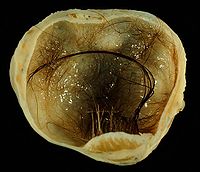
Photo from wikipedia
Rationale: Malignant transformations of ovarian mature cystic teratomas (MCTs) occur rarely, especially in young women. Although it is extremely difficult to diagnose them, serum tumor marker level testing in combination… Click to show full abstract
Rationale: Malignant transformations of ovarian mature cystic teratomas (MCTs) occur rarely, especially in young women. Although it is extremely difficult to diagnose them, serum tumor marker level testing in combination with the use of imaging techniques may be useful in preoperative diagnosis. Patient concerns: We present the case of a 31-year-old Chinese woman with the malignant transformation of an ovarian MCT. The patient had a history of oophorocystectomy due to an MCT of the right ovary 6 years prior and a gemellary pregnancy owing to in vitro fertilization and embryo transfer. Her serum CA19-9 levels were persistently mildly elevated after the first surgery. Diagnoses: She was diagnosed with ovarian squamous carcinoma, arising from an MCT (International Federation of Gynecology and Obstetrics stage IA). Interventions: A right salpingo-oophorectomy and omentectomy were performed and the patient underwent chemotherapy. Outcomes: The patient was disease-free at the 6-month follow-up. Lessons: The malignant transformation of MCTs usually occurs in postmenopausal women with poor prognoses; it is very rarely observed in young women. Although the early detection and complete surgical resection of the tumor are crucial to survival, preoperative diagnosis of this malignancy is difficult. This case reiterates the fact that malignant transformation of MCTs can occur at any age. Rapid tumor growth along with persistently elevated tumor marker levels may be indicative of the malignant transformation of MCTs.
Journal Title: Medicine
Year Published: 2018
Link to full text (if available)
Share on Social Media: Sign Up to like & get
recommendations!